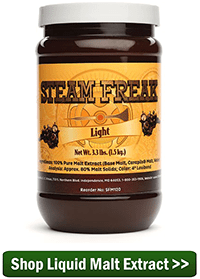 Wheat has been used in making beer for hundreds, probably thousands of years. In Germany, it was once such a popular ingredient that the government implemented Reinheitsgebot, which put a restriction on brewing with wheat to make sure there was enough wheat for making bread.
Wheat has been used in making beer for hundreds, probably thousands of years. In Germany, it was once such a popular ingredient that the government implemented Reinheitsgebot, which put a restriction on brewing with wheat to make sure there was enough wheat for making bread.
Modern home brewers have no such restriction. There are several styles of beer we enjoy today that call for the use of wheat:
- American wheat beers, weizens, witbiers, and weissbiers are brewed with high proportions of wheat in the malt bill (sometimes 50 percent or more).
- There are a number of other beer styles where we might see a smaller proportion (20 percent or less) of wheat used for body or flavor, such as in Belgian saisons.
- Wheat may also be used in small amounts (up to 10 percent) to improve body or head stability in other styles, such as pale ales or stouts.
- Lambics are often brewed with about 30% unmalted wheat.
Home brewing with wheat malt vs. barley malt
When home brewing with wheat, it’s important to think about some of the differences between wheat and barley:
- Flavor – Compared to barley, wheat has a flavor that’s more, well, wheaty or bread-like. It’s often used to help make beers smoother in both flavor and mouthfeel. These characteristics often make wheat a good base malt for fruit beers.
- No husk – Wheat also has no husk and a smaller kernel, which come into play when brewing all-grain beers. The lack of husk makes it a little more challenging when lautering, but on the other hand, no husk means less tannins.
- Protein – Finally, wheat generally has a higher protein content than barley. This is why wheat is often used to improve head stability. The flip side is that the higher protein content can make the beer more hazy.
Different ways to go about home brewing with wheat:
- Wheat extract
 – The easiest way to start home brewing with wheat is to us wheat malt extract. Use it in the same way you would any other dry or liquid malt extracts. Steam Freak Wheat LME is typically 65 percent wheat and 35 percent barley, whereas the Munton’s Wheat DME is 55 percent wheat and 45 percent barley. These ratios are important to keep in mind in terms of flavor and when converting an extract recipe to all grain.
– The easiest way to start home brewing with wheat is to us wheat malt extract. Use it in the same way you would any other dry or liquid malt extracts. Steam Freak Wheat LME is typically 65 percent wheat and 35 percent barley, whereas the Munton’s Wheat DME is 55 percent wheat and 45 percent barley. These ratios are important to keep in mind in terms of flavor and when converting an extract recipe to all grain.
- Malted Wheat – Malted wheat needs to be mashed. Since wheat has no husk, it’s often recommended to us rice hulls along with it to improve filterability through the grain bed. We carry both Red Wheat Malt, which has an assertive wheat flavor, and White Wheat Malt, which is a little more subtle.
- Flaked Wheat – Flaked wheat is unmalted wheat which has been processed through hot rollers. This process gelatinizes the starches so you don’t have to worry about converting sugars in the mash.
- Torrified Wheat – Torrified wheat has been ruptured (sort of like popcorn) to make the starches in the grain more accessible. It should be mashed with a standard base malt for conversion to take place.
- Unmalted Wheat – Raw, unmalted wheat is sometimes used for flavor, body, and head stability, but won’t contribute much in the way of fermentable sugars unless it is cooked in the brewhouse.
Do you like to home brew with wheat? What are your favorite styles of wheat beer?
—–
David Ackley is a beer writer, brewer, and self-described “craft beer crusader.” He holds a General Certificate in Brewing from the Institute of Brewing and Distilling and is founder of the Local Beer Blog.

Craig – Some malted or flaked wheat (~1 lb. in a 5 gallon batch), will contribute some of that smoothness you’re looking for. You could also try brewing a "wheat wine" — basically a beefed up version of an American wheat ale.
Cheers,
David
Listening-I like a barley wine-do you have info or suggestions for wheat properties added to the mix-love the stout smooth tastes of the barley wines but could see the advantages of wheat added to the reciepes